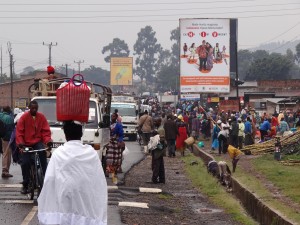Economic growth won’t be enough to help Uganda’s poorest
The 2013 Chronic Poverty Report from Uganda (authored by our partners DRT Uganda, and the Chronic Poverty Research Centre) makes sobering reading. Entitled “Is anybody listening?” the report emphasises the continuing multi-dimensionality of Ugandan poverty. The title refers to what the authors see as as a fundamental disconnect between the Ugandan chronically poor, and Ugandan policymakers; caused by a failure on the part of Ugandan leadership to include poor people in policymaking, as well as a failure to communicate effectively.
A headline finding of the CPR is that economic growth will likely not be enough to eradicate the chronic poverty which persists in Uganda. The report also finds that targeted social protection policies (as well as policies that ensure inclusion into public services for poorer and marginalised groups), need reviewing and consolidating: to “get rid of those that are not working, and focus effort on those that are or can.” It contains analysis both of the data on those living in chronic poverty, and the social welfare policy environment in Uganda; research carried out largely by local organisations (including support from some of our colleagues in the Africa hub).
How many poor people in Uganda?
The second chapter of the Uganda CPR was an especially interesting read for us at DI. (We recently reported on the distribution and depth of poverty, relative to governments’ capacity to respond to this challenge, and projected future global poverty trends until 2030, in Chapter 1 of our Investments to End Poverty report.) The CPR authors analyse data on Ugandan poverty, mainly from national household surveys (taken in 2005/6 and updated with a smaller sample in 2010). The following findings stood out for me:
- Chronic poverty in Uganda, though it has halved since the 1990s, still persists: around one in ten households are still trapped in poverty (11.6%) and unable to meet their most basic needs. According to the graph on p6 of the CPR, about 7.5 million people are in absolute poverty in Uganda.
- Nearly half of all poor households are chronically poor, or in long-term, persistent poverty (48.8% in 2009/10). (For a more in-depth explanation of what constitutes ‘chronic poverty’, visit the CPRC webpage)
- The number of ‘insecure non-poor’ individuals, those with consumption levels between the poverty line and twice the poverty line, has also increased- see below. The report calls this a ‘new group of vulnerable people.” It is certainly a group that policymakers should pay increasing attention to.
Economic growth will leave the poorest behind- without targeted social protection policies
A strong message in the CPR is that the potentially positive benefits of predicted economic growth in Uganda are in danger of being offset by the country’s increasing economic and social inequality. This is caused by (in part) rural-urban migration and its impacts; as well as loss of livelihoods in the agricultural sector from environmental stress and climate change.

Market at Kisoro. Credit: Adam Jones
More efforts are needed to make growth work better for the poor. Social protection policies can play a vital role in mitigating any impacts of economic growth on the poorest, where they are failing to benefit from it. The report takes a detailed look at the emergence of social protection policy programmes in Uganda, and notes that Uganda is still experiencing basic challenges to implementing or targeting successful SP policies; they cite ‘lack of political will” and a number of other contributing social, political and structural factors.
The foreword by the Minister of State for Gender Labour and Social Development, whose ministry leads on social protection interventions, states that more coherent policies across the Ugandan government are needed in Uganda; to sustain the impact of the welfare interventions through a more “equitable distribution of resources” in Ugandan society.
Collaboration, cross-working and coherent policies
For us at DI, the messages of the Uganda CPR will resonate as we follow post-2015 debates on what will replace the MDGs- and how we finance the end of poverty by 2030. The report reminds us just how urgent it is to get agreement on the priorities here. Even more importantly, it provides clear evidence that building consensus across all stakeholder groups- private sector, donors, governments, CSOs and multilateral agencies- is essential if we are to eradicate poverty by 2030. Growth-focused development strategies which are aimed at eradicating poverty, but which make no provision for those in chronic poverty (the elderly; the disabled; those in isolated rural areas with lack of access to opportunity, education and jobs; those vulnerable to climate change and disaster) could be counter-productive and remove the positive impacts of growth in the long term. This would risk putting our shared objectives, of “leaving no-one behind”, out of reach.
Detailed analysis of chronic poverty in the East African region will be found in the upcoming East African Chronic Poverty report, a collaborative effort with the CPRC and other organisations.
Related content
Priorities for the UK’s incoming Secretary of State Alok Sharma
As Alok Sharma takes office as Secretary of State, DI's Amy Dodd sets out key priorities for the UK and its global development agenda.
From review to delivery on the Global Goals – what should the immediate priorities be for the UK government?
On 26 June, the UK government published its Voluntary National Review measuring delivery against the Global Goals - but does it accurately capture progress?
Three priorities for the High-level Political Forum 2019
DI Director of Partnerships & Engagement Carolyn Culey sets out three key priorities for closing the gap between the poorest and the rest at HLPF 2019
